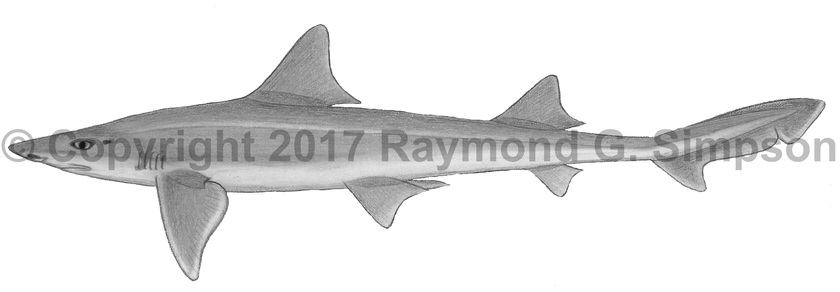
Common Name
Florida Smoothhound
Year Described
Springer, 1939
Identification
A small and slender shark with two large dorsal fins (more slender than Mustelus canis). Mouth with labial furrows equal in length. Teeth small and low with stumpy cusps. Upper jaw: 60-65 rows. Lower jaw: 55-60 rows. Eye large with a prominent spiracle less than eye diameter behind it. Snout short (<6.5% TL). Nostril with projecting tabs. Distance between nostrils 2.3-2.8% TL. Dorsal fins lack spines. Second dorsal fin about 75% as high as the first. First dorsal origin over rear base of pectoral fin. Second dorsal fin origin anterior to anal fin origin but well behind pelvic free tip. Pectoral fin relatively long and thin with a pointed tip. Pelvic and anal fins much smaller than second dorsal fin. No precaudal pits. Caudal fin with a prominent hooked and pointed lower lobe. Skin with overlapping single-pointed denticles with 2 converging ridges.
Color
Body uniformly gray to gray-brown above grading to pure white or cream below. No spots or markings on body. Fins sometimes with pale edging.
Size
Maximum size to 115cm TL. Mature adults over 57cm TL.
Habitat
A shallow living species found in coastal waters of less than 10m year round. The deepest records are ~85m.
Range
Known from southern Florida into the Gulf of Mexico, and along continental margins to northern South America and off southern Brazil.
References
Castro, J.I. 2011. The Sharks of North America. Oxford University Press, 640 pp.
Compagno, L., M. Dando, and S. Fowler. 2005. Sharks of the World. Princeton University Press, 480 pp.
Heemstra, P.C. 1997. A review of the smooth-hound sharks (genus Mustelus, family Triakidae) of the western Atlantic Ocean, with descriptions of two new species and a new subspecies. Bulletin of Marine Science, 60(3), 894-928.
Other Notes
Appears to be absent from insular localities. The taxonomy and range of the Brazilian population of this species (and Mustelus canis) need to be investigated as it is disjunct.
Mustelus higmani and M. norrisi are similar to each other but differ in denticle morphology and snout length (Heemstra, 1997).